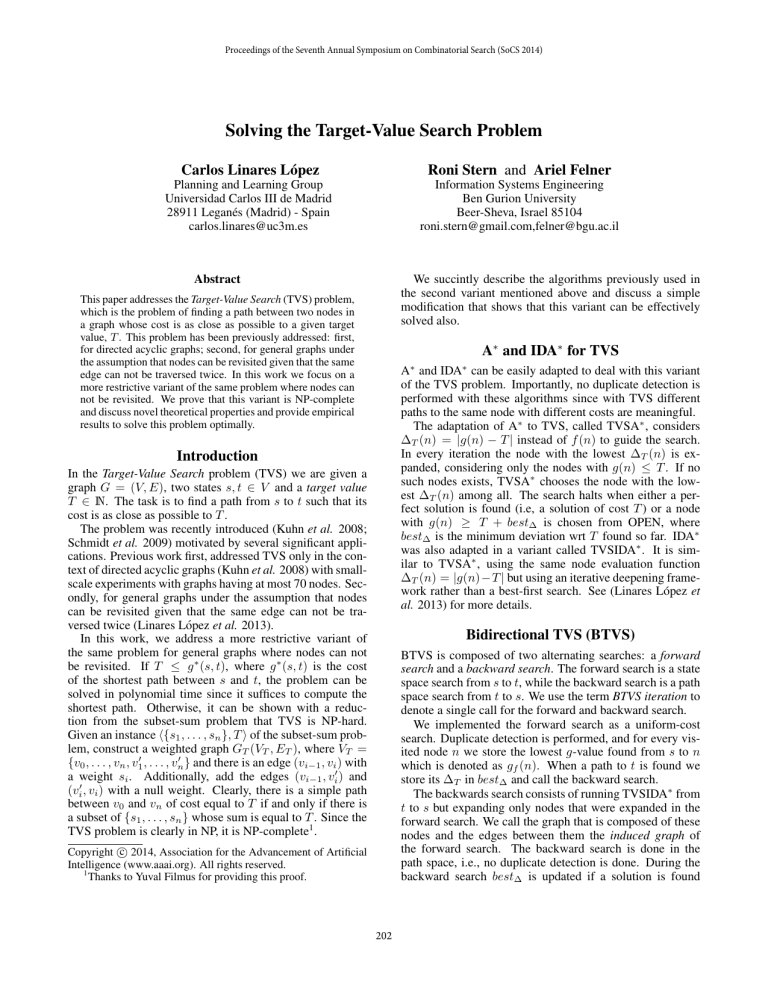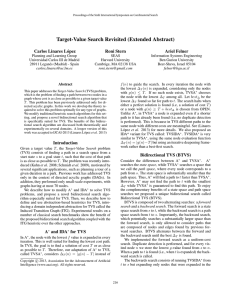
Proceedings of the Seventh Annual Symposium on Combinatorial Search (SoCS 2014)
Solving the Target-Value Search Problem
Carlos Linares López
Roni Stern and Ariel Felner
Planning and Learning Group
Universidad Carlos III de Madrid
28911 Leganés (Madrid) - Spain
carlos.linares@uc3m.es
Information Systems Engineering
Ben Gurion University
Beer-Sheva, Israel 85104
roni.stern@gmail.com,felner@bgu.ac.il
Abstract
We succintly describe the algorithms previously used in
the second variant mentioned above and discuss a simple
modification that shows that this variant can be effectively
solved also.
This paper addresses the Target-Value Search (TVS) problem,
which is the problem of finding a path between two nodes in
a graph whose cost is as close as possible to a given target
value, T . This problem has been previously addressed: first,
for directed acyclic graphs; second, for general graphs under
the assumption that nodes can be revisited given that the same
edge can not be traversed twice. In this work we focus on a
more restrictive variant of the same problem where nodes can
not be revisited. We prove that this variant is NP-complete
and discuss novel theoretical properties and provide empirical
results to solve this problem optimally.
A∗ and IDA∗ for TVS
A∗ and IDA∗ can be easily adapted to deal with this variant
of the TVS problem. Importantly, no duplicate detection is
performed with these algorithms since with TVS different
paths to the same node with different costs are meaningful.
The adaptation of A∗ to TVS, called TVSA∗ , considers
∆T (n) = |g(n) − T | instead of f (n) to guide the search.
In every iteration the node with the lowest ∆T (n) is expanded, considering only the nodes with g(n) ≤ T . If no
such nodes exists, TVSA∗ chooses the node with the lowest ∆T (n) among all. The search halts when either a perfect solution is found (i.e, a solution of cost T ) or a node
with g(n) ≥ T + best∆ is chosen from OPEN, where
best∆ is the minimum deviation wrt T found so far. IDA∗
was also adapted in a variant called TVSIDA∗ . It is similar to TVSA∗ , using the same node evaluation function
∆T (n) = |g(n)−T | but using an iterative deepening framework rather than a best-first search. See (Linares López et
al. 2013) for more details.
Introduction
In the Target-Value Search problem (TVS) we are given a
graph G = (V, E), two states s, t ∈ V and a target value
T ∈ N. The task is to find a path from s to t such that its
cost is as close as possible to T .
The problem was recently introduced (Kuhn et al. 2008;
Schmidt et al. 2009) motivated by several significant applications. Previous work first, addressed TVS only in the context of directed acyclic graphs (Kuhn et al. 2008) with smallscale experiments with graphs having at most 70 nodes. Secondly, for general graphs under the assumption that nodes
can be revisited given that the same edge can not be traversed twice (Linares López et al. 2013).
In this work, we address a more restrictive variant of
the same problem for general graphs where nodes can not
be revisited. If T ≤ g ∗ (s, t), where g ∗ (s, t) is the cost
of the shortest path between s and t, the problem can be
solved in polynomial time since it suffices to compute the
shortest path. Otherwise, it can be shown with a reduction from the subset-sum problem that TVS is NP-hard.
Given an instance h{s1 , . . . , sn }, T i of the subset-sum problem, construct a weighted graph GT (VT , ET ), where VT =
{v0 , . . . , vn , v10 , . . . , vn0 } and there is an edge (vi−1 , vi ) with
a weight si . Additionally, add the edges (vi−1 , vi0 ) and
(vi0 , vi ) with a null weight. Clearly, there is a simple path
between v0 and vn of cost equal to T if and only if there is
a subset of {s1 , . . . , sn } whose sum is equal to T . Since the
TVS problem is clearly in NP, it is NP-complete1 .
Bidirectional TVS (BTVS)
BTVS is composed of two alternating searches: a forward
search and a backward search. The forward search is a state
space search from s to t, while the backward search is a path
space search from t to s. We use the term BTVS iteration to
denote a single call for the forward and backward search.
We implemented the forward search as a uniform-cost
search. Duplicate detection is performed, and for every visited node n we store the lowest g-value found from s to n
which is denoted as gf (n). When a path to t is found we
store its ∆T in best∆ and call the backward search.
The backwards search consists of running TVSIDA∗ from
t to s but expanding only nodes that were expanded in the
forward search. We call the graph that is composed of these
nodes and the edges between them the induced graph of
the forward search. The backward search is done in the
path space, i.e., no duplicate detection is done. During the
backward search best∆ is updated if a solution is found
Copyright c 2014, Association for the Advancement of Artificial
Intelligence (www.aaai.org). All rights reserved.
1
Thanks to Yuval Filmus for providing this proof.
202
with ∆T < best∆ . The backward search halts when either best∆ is proven to be the solution or when all paths in
the induced graph were visited. In the latter case, we run
the forward search again until the f -value of all nodes is
larger or equal than T + best∆ . In addition, the backwards
search is equipped with additional pruning and ordering criteria (Linares López et al. 2013).
∗
TVSA
TVSIDA∗
BTVS
T∗
Theorem 1 BTVS is sound and complete and after precisely
two BTVS iterations the path with the lowest ∆T is guaranteed to be found.
TVSA∗
TVSIDA∗
BTVS
T∗
The Induced Transition Graphs
Experiments with BTVS have shown it to have better performance than TVSA∗ and TVSIDA∗ . However, it is still
feasible to speed it up by choosing smartly when should
the backward search be run, and when the forward search
should continue to search and reveal more nodes. The original idea consisted of introducing a novel heuristic called Induced Transition Graph (ITG) (Linares López et al. 2013).
An ITG is an abstraction of the state space where all the
nodes with the same g value are mapped into a single node.
Every node in the ITG is labelled according to the gf value
of the nodes in the original search space that are mapped to
it. An edge between nodes i and j in the ITG exists iff the
forward search encountered such an edge (between nodes
with the corresponding g value). For this particular variant,
let li denote the number of nodes in the original state space
with gf (·) = i. A path P 0 in the ITG is called an ITG traversal if it is a path from s0 to t0 such that every node i exists in
P 0 at most li times. It is easy to see that every path from s to
t that is found by the backwards search has a corresponding
ITG traversal of the same length.
Thus, instead of performing the backwards search to
check if it contains a better path, one can enumerate all the
ITG traversals and check whether there is an ITG traversal P 0 such that |T − |P 0 || < best∆ . This technique was
used to restrict the backward searches in BTVS: a backward
search is only applied if there is an ITG traversal P 0 such
that |T − |P 0 || < ∆T (Pbest ). We denote with T∗ to BTVS
with ITGs used in this way.
In the particular case that interests us here where only single paths are allowed, this idea however does not suffice because it implicitly assumes that the same node n in the original state space can be used to move between two nodes with
the same gf value. Thus, a simple modification consists of
recording in the ITG the number of nodes with two or more
parents. We demonstrate it in domains with unit edge cost
where dynamic programming can be used to allow BTVS to
use the ITG with constant overhead, in a similar way as it
was previously done (Linares López et al. 2013).
5
6
even
7
8
9
353
202
377
400
359
102
373
373
117
69
380
380
18
40
390
390
10
23
390
390
5
6
odd
7
8
9
351
196
371
400
357
103
372
372
115
69
380
380
19
40
390
390
10
23
390
390
Table 1: # instances solved for various sizes of the N pancake puzzle
puzzle and the pancake puzzle. All the experiments have
been performed on an Intel Xeon 2.93 GHz Quad core processor (64 bits) using Linux with a time cutoff of 120 seconds and 2 Gb of memory. A small part of these experimental results can be viewed in Table 1, which shows the number
of instances solved, out of 400, for a wide range of even and
odd target values, T . As can be seen, BTVS and T∗ are able
to solve substantially more instances than its competitors in
this domain as well as in the others.
References
Lukas Kuhn, Tim Schmidt, Bob Price, Johan de Kleer, Rong
Zhou, and Minh Do. Heuristic search for target-value path
problem. In The First International Symposium on Search
Techniques in Artificial Intelligence and Robotics, 2008.
Carlos Linares López, Roni Stern, and Ariel Felner. Targetvalue search revisited. In Proceedings of the Twenty-Third
International Joint Conference on Artificial Intelligence (IJCAI 2013), pages 601–607, Beijing (China), August 2013.
Tim Schmidt, Lukas Kuhn, Bob Price, Johan de Kleer, and
Rong Zhou. A depth-first approach to target-value search.
In Symposium on Combinatorial Search (SOCS-09), 2009.
Theorem 2 Let us denote with best0∆ the minimum deviation of the best solution found after the first iteration
of BTVS. The number of iterations of T∗ is bounded by
(T + best0∆ − gf (s, t)).
Experimental Results
We evaluated the performance of TVSA∗ , TVSIDA∗ BTVS
and T∗ on the 4-connected grid pathfinding, the sliding-tile
203









